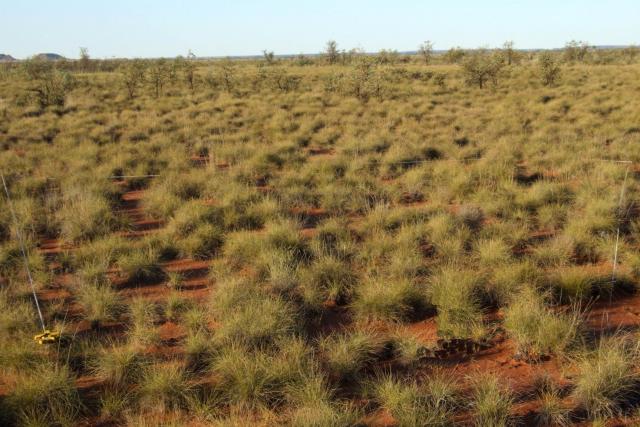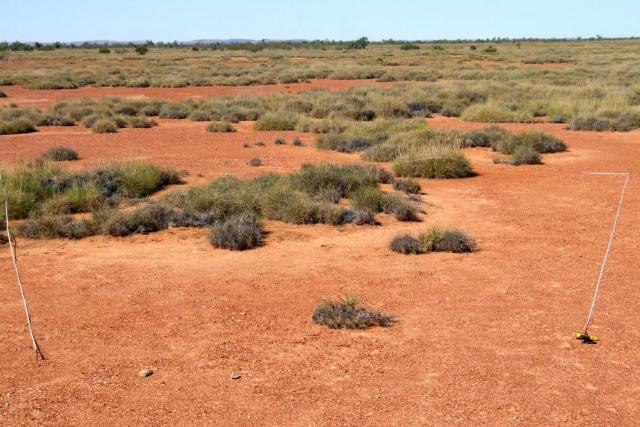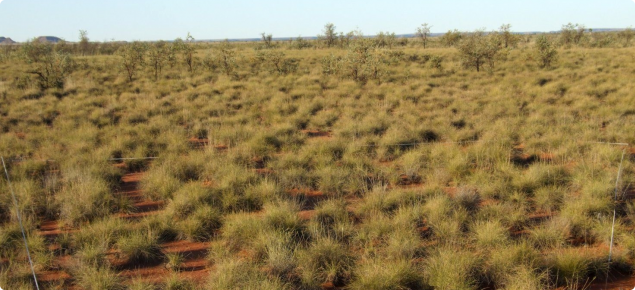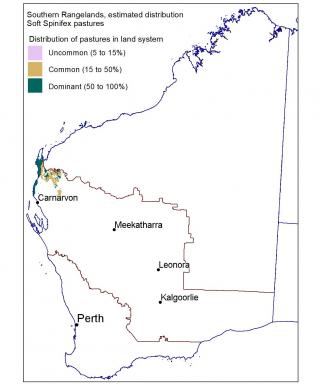Pastoral potential – moderate to high
Soft spinifex pastures have high pastoral value when plants are young and a range of other grasses, herbs and forbs are present. Grazing value is reduced to moderate in older stands and may be low in very old stands. Crude protein levels as high as 9% have been reported in soft spinifex (Triodia pungens) seedlings. Older spinifex plants are less palatable and have low digestibility.
Suggested levels of use (per annum)
Table 1 provides a rough guide to the range of pastoral values for good condition pastures, which must be checked against conditions in each region and paddock. Carrying capacities for fair condition pastures might be 75% to 50% of good, and poor condition pastures less than 50% of good.
See Introduction to pastures in the southern rangelands of Western Australia for an explanation of how carrying capacities are estimated. Carrying capacity expressed as 105–139/36–69 is moderate/high.
| Condition | Carrying capacity ha/DSE1 | Carrying capacity ha/CU2 (ha/AE3) |
|---|---|---|
| Good | 15–19.9/5.1–9.9 | 105–139 to 36–69 (126–167 to 43–83) |
1 DSE is based on the feed energy required to maintain a 45 kilogram liveweight Merino wether with zero weight change, no wool growth additional to that included in maintenance, and walking 7 km/day. 1 DSE has an energy requirement of approximately 8.7 MJ ME/day.
2 CU in the southern rangelands is based on a 400 kg steer at maintenance and equivalent to 7 DSE.
3 AE is based on the feed energy to maintain a 450 kg Bos taurus steer 2.25 years of age, walking 7 kilometers each day. 1 AE has an energy requirement of approximately 73 MJ ME/day and equivalent to 8.4 DSE.
Managing soft spinifex pastures in the southern rangelands
These pastures can be maintained by a system involving periodic burning and rotational grazing. Soft spinifex pastures should be fenced separately from useful shrub pastures such as bluebush. Buffel grass pastures associated with soft spinifex pastures can be paddocked together. A buffel grass–soft spinifex mixture is desirable for rapid rain-response, nutrition and resilience in dry times. Resilience is compromised when buffel grass becomes dominant.
Grazing after fire should be deferred for at least eight weeks after effective rain. Spinifex country’s greatest value for stock or other animals is about a year after fire and subsequent rain, when diverse short-lived grasses and woody herbs germinate. The short-lived plants gradually decline in diversity as spinifex regains dominance after about five years. Rotational burning of these pastures helps to ensure that, at any given time, some areas are in the more palatable stages of growth with a wide range of plant species available for grazing.
Soft spinifex pastures are usually very stable, but wind erosion may occur on recently burnt areas which have yet to stabilise with seasonal growth.
Pasture condition
Survey and rangeland condition assessment data show that soft spinifex pastures in the southern rangelands are predominantly in fair condition.
Good
See Figure 1. The dominant grass is soft spinifex. Other perennial grasses may include oat-eared spinifex, ribbon grass, hop-along grass and buffel grass. Palatable low shrubs, such as silver saltbush, green cassia, ruby saltbush and tall saltbush may be present. Annual herbs and grasses such as wind grass may also be present. Plants are vigorous, productive and evenly spaced. The size and density of plants in the stand depends on time elapsed since fire, seasonal conditions and grazing pressure.
Fair
See Figure 2. As pasture condition declines from good to fair, less desirable and unpalatable species such as Flinders River poison become more prominent, though soft spinifex is still dominant. Soft spinifex plants may be less vigorous and other desirable species are hard to find. A decline to fair condition is usually accompanied by reduced frequency and vigour of the palatable species such as saltbushes and split leaf buttercup bush. The coverage of spinifex plants may appear patchy or uneven, with the areas between supporting a sparse cover of annuals and undesirable perennial plants (e.g. wind grass and undesirable cassias). Poor grazing management after fire can cause an uneven distribution of perennial species in these pastures.
Poor
Soft spinifex pasture that has declined to poor condition will most likely be dominated by unpalatable cassias, herbs or annuals with low fodder value. There may be dense shrub thickets making it difficult for stock to access the grass or there may be large bare areas. Where soft spinifex pasture in poor condition is adjacent to hard spinifex pasture, bare areas may be colonised by hard spinifex. Palatable grasses lack vigour or are absent. The abundance of annual grasses depends on the season. Dense thickets of cockroach bush after fire indicate poor condition in these pastures.


Vegetation structure and composition
Vegetation structure and composition are variable in soft spinifex pastures and are influenced by time elapsed since fire and prevailing climatic conditions. Pastures may take the form of hummock grasslands, tall or low shrublands or, very occasionally, low woodlands. These pastures are prone to fire. Early successional stages often take the form of low shrubland, as colonising perennial shrubs become dominant, together with spinifex seedlings. About five years after burning, soft spinifex may regain dominance as the shrubs die or are out competed by the expanding spinifex hummocks. Pastures that are managed conservatively will eventually resume their form as hummock grasslands with little or no shrub cover, whereas over utilised pastures will become shrub-dominated.
Soft spinifex pastures occur most commonly as hummock grasslands. The ground layer is dominated by soft spinifex and sometimes oat-eared spinifex. These species may account for nearly all of the total projected foliar cover (PFC) which may be up to 50%. Hard spinifex is occasionally co-dominant with soft spinifex. Soft wanderries and neverfail may form useful stands in these pastures. Buffel grass may be present. Spinifex cover rarely exceeds 10% in shrub-dominated pastures. PFC of the shrubs may reach 30%. The more widespread low shrubs include bloodbush, ruby saltbush, cotton bush and flannel bush. Mid shrubs may include hopbush, Rhagodia preissii and others. Tall shrubs that may be dominant include curara and pebble bush.
Occurrence
Soft spinifex pastures mainly occur in the Pilbara and Kimberley, and also in the western Gascoyne and Ashburton. In the southern rangelands they cover an estimated 0.5 million hectares (0.6% of the southern rangelands). They are associated with landforms developed on marine deposits and often covered with a veneer of aeolian sand in the Carnarvon Basin. They occur on longitudinal dunes and swales, undulating sandy plains, limestone rises, platforms and low hills, loamy plains and interfluves and some flow zones.
Associated plants
| Common name | Scientific name (links to FloraBase) | Desirability* |
|---|---|---|
| No data | D | |
| No data | D | |
| Buffel grass | D | |
| Cotton bush | D | |
| Flat leaf bluebush | D | |
| Green cassia | D | |
| Neverfail | D | |
| Mingah bush, bullock bush | D | |
| Oat-eared spinifex | D | |
| Ragged leaf fanflower | D | |
| Ribbon grass | D | |
| Ruby saltbush | D | |
| Silver saltbush | D | |
| Soft spinifex | D | |
| Soft spinifex | D | |
| Split leaf buttercup bush | D | |
| Tall saltbush | D | |
| Cockroach bush | U | |
| Crinkle leaf cassia | U | |
| Erect kerosene grass | U | |
| Fitzroy wattle | U | |
| Flinders River poison | U | |
| Hard spinifex | U | |
| Poverty wattle | U | |
| Shark Bay poverty bush | U | |
| Rhagodia | I | |
| Bloodbush | I | |
| Buck wanderrie grass | I | |
| Curara | I | |
| Flannel bush | I | |
| Grey fanflower | I | |
| Hard spinifex | I | |
| Hop-along grass | I | |
| Hopbushes | Dodonaea spp. | I |
| Ranji bush | I | |
| Limestone spinifex | Triodia wiseana | I |
| Limestone wattle | I | |
| Myrtles | Thryptomene spp. | I |
| Naked lady | I | |
| Pebble bush | I | |
| Two-veined wattle | I | |
| Wire grass | I | |
| Woollybutt grass | I | |
| Butterfly bush | N | |
| Firebush | N | |
| Wind grass | annual |
* D = desirable, U = undesirable, I = intermediate, N = no indicator value


